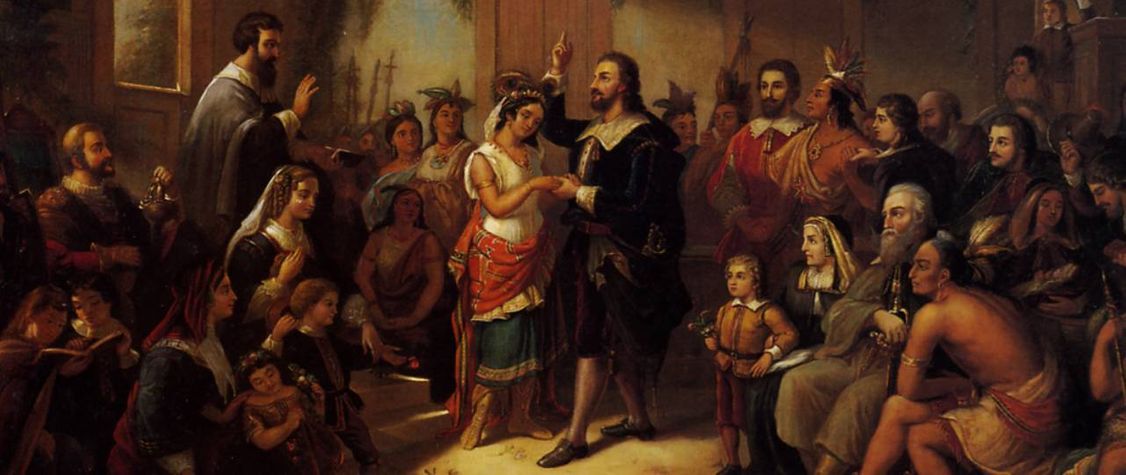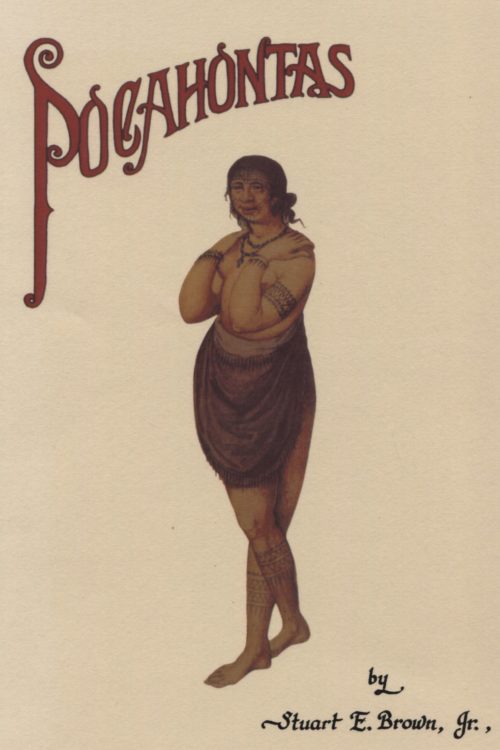
“She was of a ‘Coulour browne, or rather tawnye,’ and her age was somewhere between twelve and fourteen. She probably was roundfaced, with the fore part of her ‘grosse’ and ‘thick’ black hair ‘shaven close,’ and the very long ‘thicker part’ being ‘tied in a pleate hanging down’ to her hips. Her hands almost certainly were ‘pretty.’ Her ‘handsome lymbes,’ breast, ‘slender armes’ and face may well have been cunningly tattooed. And she probably wore a headband or crownlet and copper-decorated beads and earrings, her head and shoulders being covered with red colored powder ‘mixed with the oyle of the walnut, or Beares grease.’ In winter this paint ‘armes (in some measure) against the Cold’ and ‘in Summer doth check the heat’ while helping to defend ‘from the stinging of Muskeetoes which here breed aboundantly, amongst the marish whorts, and fenburies.’
“Her name was Matoaka, but they called her Pocahontas, the appellation possibly being derived from the Algonkian adjective meaning ‘playful, sportive, frolicsome, mischievous, frisky.’
“She was a member of one of a confederacy of some thirty well-organized, thriving agricultural and fishing tribes, who lived in approximately 160 villages widely scattered over much of the lower section of the Chesapeake Bay, and had a total population in the neighborhood 9000. And she was one of the many children of Powhatan, the confederacy’s overlord or supreme ‘werowance’.”
Thus begins the late Stuart Brown’s diminutive biography of the legendary Native American princess who saved the life of Captain John Smith of Jamestown fame. Mr. Brown, an attorney and antiquarian bookman by day, devoted much of his spare time to recording everything that could be found out about Pocahontas and her progeny. His biography, entitled POCAHONTAS, which occupies a mere 36 pages, uses only contemporary or near-contemporary facts pertaining to Pocahontas’s appearance, words, and actions. It is fully documented and features a number of reproductions of engravings made of the princess, her father, and scenes from early 17th-century Virginia.
Stuart Brown’s concern for accuracy is reflected in his recounting of Pocahontas’s final years. These are the bare facts: In April 1614, Pocahontas was married to the English gentleman John Rolfe, who had succeeded Thomas Dale as the secretary of the Virginia Colony. Pocahontas bore Rolfe a son, Thomas, in late 1614 or early 1615. That year the three of them, along with Pocahontas’s sister Matchama and her husband and several other Powhatan Indian men and women, sailed for England. Pocahontas enjoyed a period of celebrity while abroad before the John Rolfe family embarked on the return voyage in 1617. Sadly, Pocahontas died suddenly at Gravesend, a Thames River port located downstream from London. Apparently believing that his young son was too ill to continue on the voyage, John Rolfe left Thomas in the care of his brother, Henry.
In 1632, Pocahontas’ and John Rolfe’s son Thomas married Elizabeth Washington. Elizabeth gave birth to a daughter, Anne Rolfe, but Elizabeth died shortly thereafter. Anne married Peter Elwyn in 1659 and bore him three sons and four daughters. For his part, Pocahontas’ son Thomas Rolfe chose to return to Virginia in 1635. His daughter Jane was born in 1655, though the ancestry of Jane’s mother is still a matter of conjecture. Jane married Col. Robert Bolling in 1675, and bore him one son, John Bolling. All of Pocahontas’s descendants trace back to the progeny of either Anne Rolfe and Peter Elwyn, or Jane Rolfe and Colonel Robert Bolling.
The descendants of Princess Pocahontas, through her son Thomas Rolfe number in the tens of thousands and encompass numerous lines of the colonial Virginia and British gentry. Stuart Brown’s attention to detail is most evident in his grand opus, Pocahontas’ Descendants, a multi-volume genealogy spanning 20 years, that attempts to account for that progeny.
Pocahontas’ Descendants: A Revision, Enlargement and Extension of the List as Set Out by Wyndham Robertson in His Book, ‘Pocahontas and Her Descendants’ (1887) was published in 1985. It is the base volume to which Stuart Brown and his associates, Lorraine F. Myers and Eileen M. Chappel, ultimately published five sets of Corrections and Additions. The base volume identifies in excess of 20,000 descendants of Jane Rolfe and Robert Bolling. That book includes an Introduction to the Pocahontas line that includes a critical assessment of Wyndham Robertson’s research, a bibliography of sources, and an index in excess of 100 pages. Pocahontas’ Descendants, the consolidated book published by Genealogical.com in 1995, appends the two volumes of corrections and additions of 1992 and 1994 to the base volume of 1985, resulting in a consolidated in a work over 700 pages, with indexes containing over 30,000 names!
Third Corrections and Additions to Pocahontas’ Descendants, published in 1997, is the longest of the supplementary volumes, and it stands by itself.
The relatively small number of Corrections and Additions in the Fourth (2001) and Fifth Corrections (2004) are available in a consolidated paperback booklet first issued in 2004.






I am related also to Pocahontas thru Jane bolling.
Pocahontas was my 12fh great grandmother??